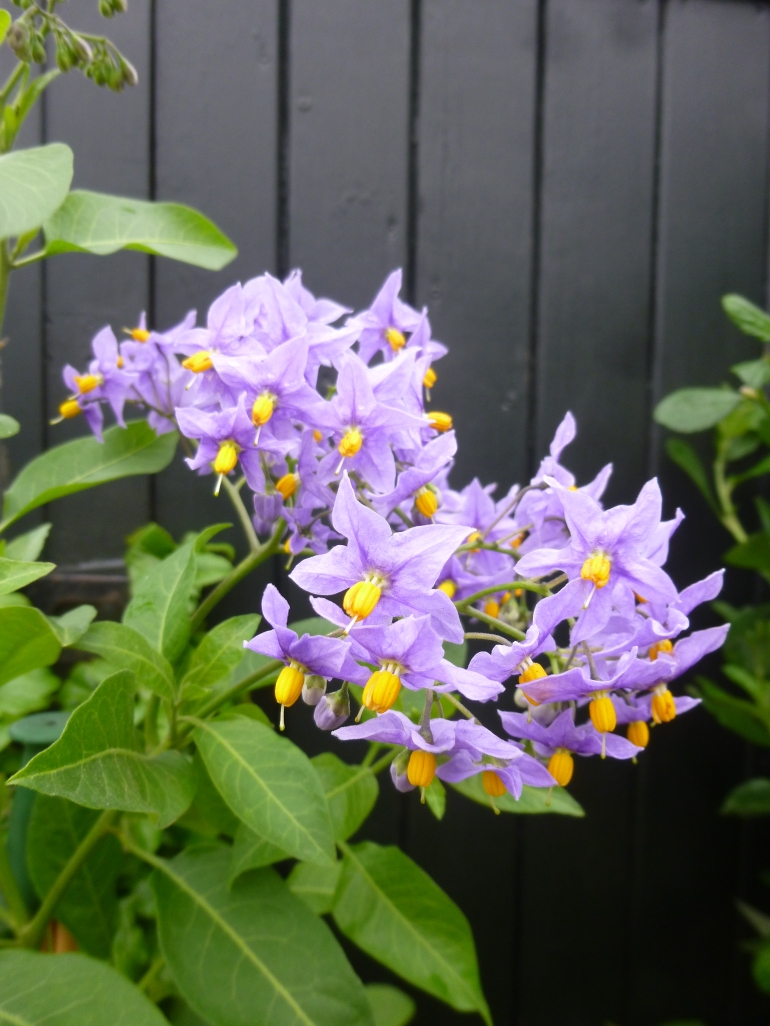Solanum crispum ‘Glasnevin’
I might try this climber, this year, in the space I have cleared in my garden, having removing a large stand of laurel – and let is scramble through the remaining shrubbery. Mine is a north-west facing garden, but one longer boundary, almost entirely obscured by Cotinus, Pyracantha, Lonicera Winter Beauty, ivy, more laurel and a rambling rose, is open, sheltered and gets all the afternoon sun on offer. Not ideal, but I think it will work.
http://www.telegraph.co.uk/gardening/howtogrow/7846747/How-to-grow-Solanum-crispum-Glasnevin.html
How to grow Solanum crispum ‘Glasnevin’
The Chilean potato tree, Solanum crispum ‘Glasnevin’ (also known as Solanum crispum ‘Autumnale’) is a plant I wouldn’t be without.
Each flower has attractive contrasting, prominent yellow stamens. In some years the flowers are followed by yellowish-white fruit, which are not edible.
It is a native of South America and was introduced to this country in the 1700s. In 1939 the Royal Horticultural Society gave it an Award of Garden Merit (AGM).
‘Glasnevin’ is slightly hardier than the species Solanum crispum, but even so I prefer to grow it in a sheltered part of the garden, preferably against a south or west-facing wall. ‘Glasnevin’ also flowers more prolifically than other species.
In mild winters it may retain its leaves, but in severe winters, such as the last one, it may drop most of them. Even though it is hardy, I thought during last winter that I had lost the one growing up my south-facing wall, but in April I was delighted to see it burst into life.
It is a vigorous plant and can grow up to 20ft but is easily controlled by pruning in spring. The stems need tying to wires on a fence or wall, but its lax habit adds to its charm and it lends an exotic feel to the garden.
Growing tips
Solanums prefer a neutral to slightly alkaline (limey), well-drained soil in full sun. A high-potash fertiliser in spring will encourage profuse flowers in summer. You will have to tie the young shoots to wires for support or alternatively let the plants scramble through other mature shrubs or grow over a pergola where the beautiful flowers hang down above your head.
To prevent the plants becoming a tangled mass, in spring, prune the flowering shoots from the previous year to two or three buds from the main stems that form the permanent framework of branches. Cut out dead shoots at the same time.
Don’t prune all old growth hard at one time as you may kill the plant. To encourage new growth from the base, cut out one or two old growths every two or three years.
You can propagate by taking semi-ripe cuttings from summer to early autumn. Take cuttings about 3in long with a heel of older wood. Put the cuttings around the edge of small pots of multi-purpose compost, place a polythene bag over them and put on a bright windowsill, but not in direct sunlight.
If you have a propagator, gentle heat will speed the formation of roots. The cuttings should root in about four weeks. Pot up individually, protect from frost over winter and plant out in spring.
Alternatively, propagate by layering. Take a stem and place it on the ground. With a trowel make a slight depression in the soil and bury a part of young growth with the growing tip out of the soil.
Cover the shoot with soil and place a large stone over it to hold the stem in place and in a few months it will form roots. Leave for a year and then dig up and plant out.
Solanums are generally trouble-free, but aphids can sometimes be a problem. All parts of the plant are poisonous and can cause discomfort if eaten.
Good companions
Although ‘Glasnevin’ and other species of solanum can grow quite large, they are well behaved and make wonderful companions for other plants. I have seen them scrambling through evergreen shrubs and mixed with climbing roses.
‘Glasnevin’ looks particularly good with pink roses such as ‘Aloha’. The small white flowers of Solanum laxum ‘Album’ make a wonderful contrast to the purple-blue of ‘Glasnevin’.
Solanums also make good partners for clematis, with the main stems of the solanum making a good support for clematis. Older solanum stems can become bare of shoots and flowers so growing with clematis helps disguise this.
I wouldn’t grow it with Clematis montana and its cultivars as they are too vigorous, but any of the late-flowering clematis hybrids such as ‘Comtesse de Bouchaud’ or species clematis make ideal partners.
The late-flowering hybrids of clematis are pruned hard in spring so these don’t overwhelm the solanum. Other sun-loving climbers, such as jasmine, make good companions. Jasminum officinale ‘Argenteovariegatum’, with white flowers, is one to try.

